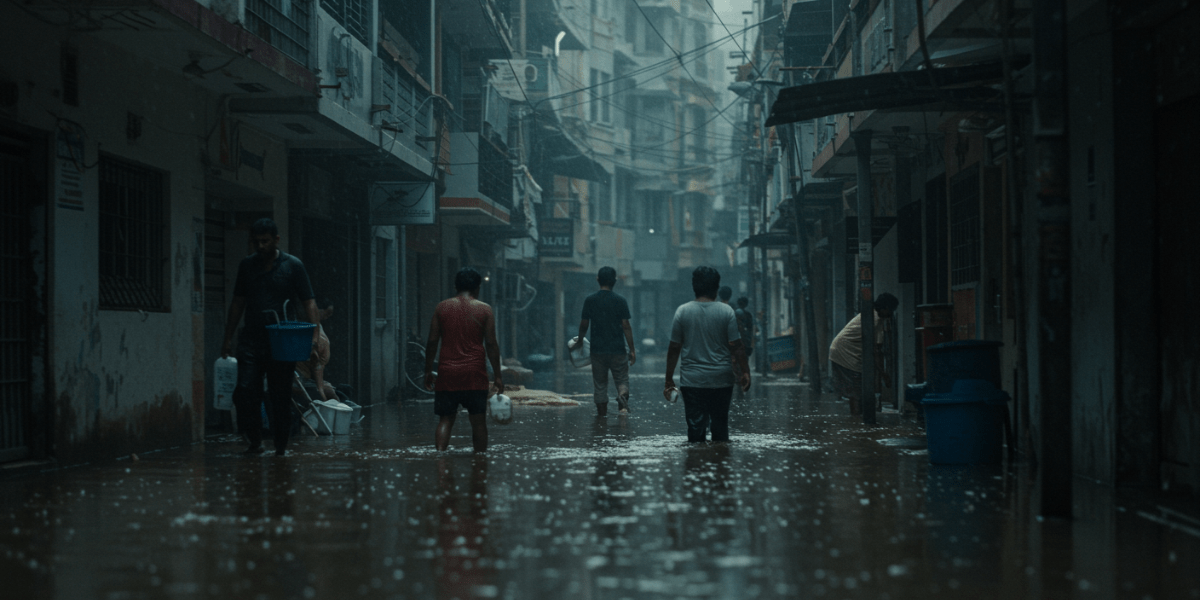
Rise of Waterborne Diseases After Urban Flooding
Urban flooding is no longer a rare occurrence—it has become a seasonal challenge for many developing cities around the world. In countries like Pakistan, where heavy monsoon rains often overwhelm outdated drainage systems, urban flooding leads to standing water, sewage overflow, and contamination of clean water sources. These conditions create a perfect breeding ground for waterborne diseases. The rise of waterborne diseases after urban flooding not only disrupts daily life but also poses a significant threat to public health.
Urban Flooding and Waterborne Diseases

Urban flooding is closely linked with the spread of infectious diseases. When floodwater mixes with sewage, it carries bacteria, parasites, and viruses into streets, homes, and water pipelines. People exposed to this contaminated water are at risk of developing illnesses such as cholera, typhoid, hepatitis A, and gastroenteritis. The connection between urban flooding and waterborne diseases is so strong that health authorities now consider floods as a major trigger for infectious outbreaks.
Impact of Flooding on Public Health
The impact of flooding on public health goes far beyond immediate physical injuries. After the water recedes, communities face weeks and even months of health challenges. Children, the elderly, and individuals with weak immune systems are the most vulnerable. Hospitals often see a sharp rise in cases of diarrhea, vomiting, dehydration, and liver infections. Malnourished individuals and those already suffering from chronic illnesses may face life-threatening complications from otherwise preventable infections.
Moreover, urban flooding disrupts essential services like clean water supply, waste disposal, and access to medical care. Pharmacies and hospitals often become overcrowded, making it difficult for people to get timely treatment. This is why health preparedness, public awareness, and preventive measures are crucial in reducing the health risks after urban flooding.
Waterborne Diseases Caused by Floods

Some of the most common waterborne diseases caused by floods include:
-
Cholera – Caused by contaminated water, leading to severe diarrhea and dehydration.
-
Typhoid fever – Spread through consumption of food or water contaminated with Salmonella typhi bacteria.
-
Hepatitis A and E – Viral infections that attack the liver, often transmitted through unsafe drinking water.
-
Leptospirosis – A bacterial infection spread through contact with floodwater contaminated by animal urine.
-
Gastroenteritis – Inflammation of the stomach and intestines, leading to nausea, vomiting, and diarrhea.
These diseases spread quickly in densely populated cities where sanitation systems fail under the pressure of heavy rains. Preventing them requires both government intervention and personal responsibility.
Health Risks After Urban Flooding
The health risks after urban flooding extend beyond immediate infections. Stagnant water becomes a breeding site for mosquitoes, increasing the chances of dengue and malaria outbreaks. Skin infections are also common when people are forced to wade through dirty floodwater. Mental health risks, including stress, anxiety, and trauma, should not be ignored, as natural disasters leave lasting emotional scars on affected communities.
For families and individuals, protecting health during flood season requires extra caution. Boiling drinking water, using water purification tablets, and ensuring proper food hygiene can drastically reduce the risk of infection.
Preventive Measures and Community Role
Governments must strengthen drainage infrastructure and improve emergency response systems to minimize flood damage. Public awareness campaigns on hygiene and vaccination also play a vital role in reducing disease burden. However, individuals and families should also take proactive steps:
-
Always drink filtered or boiled water during flood season.
-
Wash hands thoroughly before meals.
-
Store essential medicines and oral rehydration salts at home.
-
Avoid direct contact with floodwater when possible.
-
Seek immediate medical attention if symptoms of infection appear.
Pharmacies also have a crucial role to play by ensuring the availability of essential medicines, antibiotics, and vaccines during the rainy season.
Role of Pharmacies in Combating Waterborne Diseases
In flood-affected cities like Karachi, access to reliable healthcare providers is critical. The top pharmacy in Karachi, Dawa Healthcare Pharmacy, has been at the forefront of ensuring patients have uninterrupted access to life-saving medicines during emergencies. Known as a leading pharmacy in Karachi, Dawa Healthcare not only provides high-quality medicines but also promotes public health awareness.
By stocking antibiotics, oral rehydration salts, and water purification solutions, pharmacies act as first responders in times of crisis. Many families rely on trusted pharmacies to guide them on preventive measures and treatment options when hospitals are overcrowded.
Conclusion
The rise of waterborne diseases after urban flooding is a serious health challenge that demands immediate attention from both authorities and the public. Floods will continue to occur due to climate change and poor urban planning, but their devastating impact on health can be minimized through awareness, preventive measures, and reliable healthcare support.
For Karachi residents, turning to trusted healthcare providers during such times is essential. Dawa Healthcare and Dawa Healthcare Pharmacy, recognized as the top pharmacy in Karachi and a leading pharmacy in Karachi, continue to provide reliable medicines, healthcare guidance, and support during emergencies.
By working together—government, communities, and pharmacies—we can reduce the spread of waterborne diseases caused by floods and protect public health from the health risks after urban flooding.

